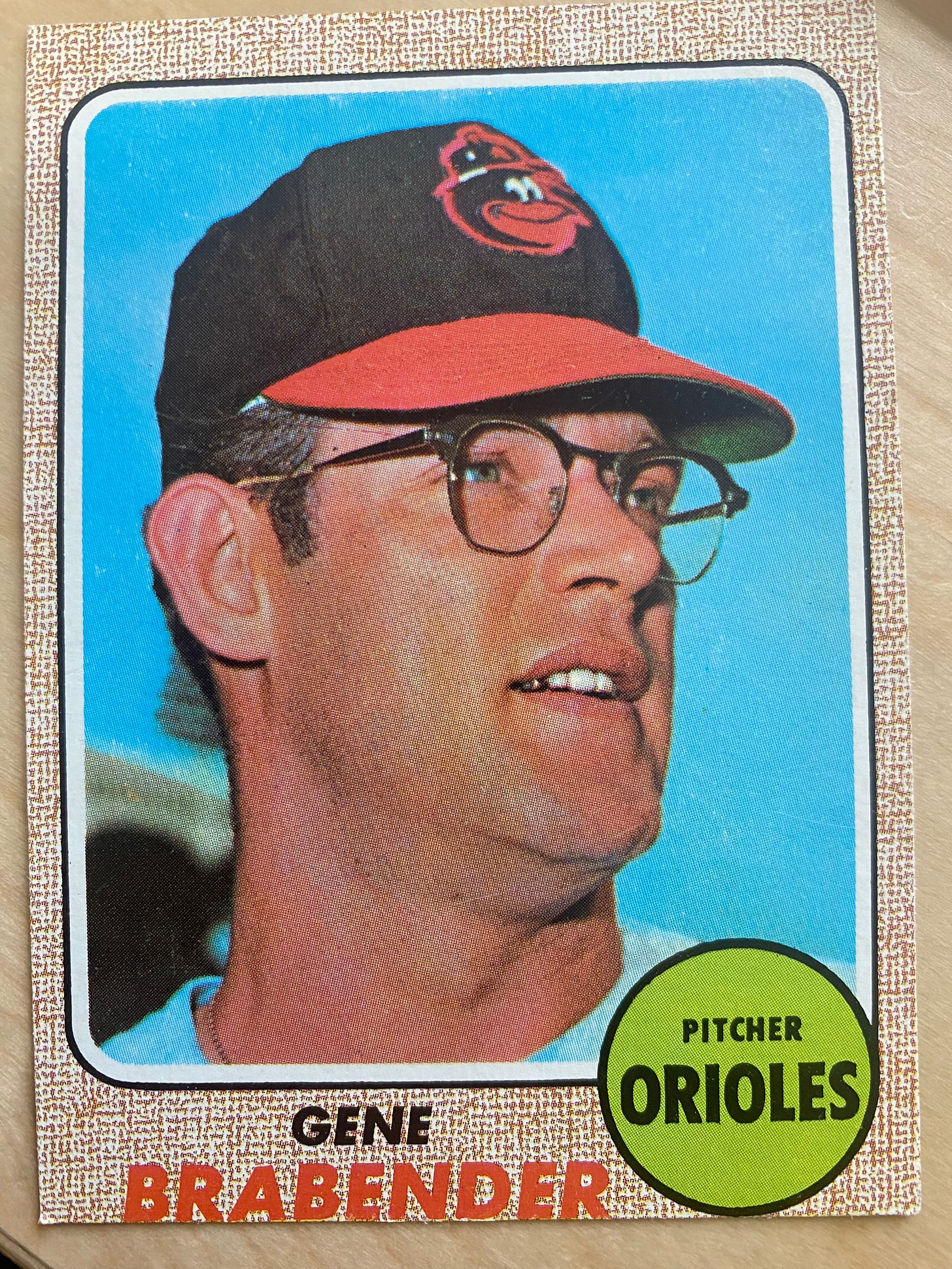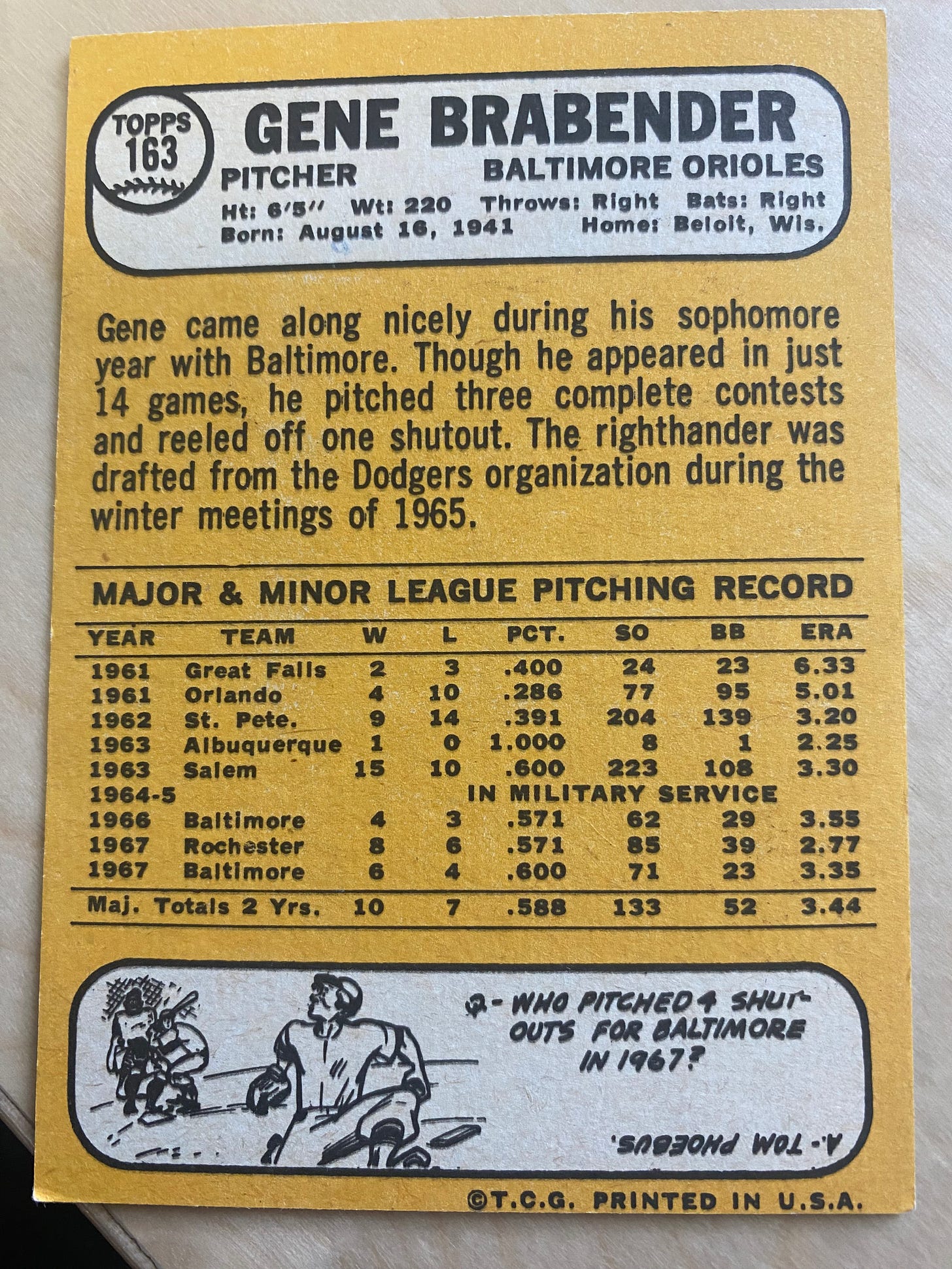Classic Card: Gene Brabender, 1968
A mammoth pitcher, he posted solid numbers for the Orioles over three seasons in the 1960s. But his larger-than-life persona and one-of-a-kind antics were more memorable than his pitching.
When the Orioles celebrated in their Memorial Stadium clubhouse after completing a sweep of the Los Angeles Dodgers in the 1966 World Series, no player celebrated harder than Gene Brabender, a mammoth rookie pitcher.
“Everyone was going nuts, but Gene really went over the top, spraying champagne all over teammates as well as sportswriters, baseball officials, and innocent bystanders,” Brooks Robinson recalled, according to a Society of American Baseball Research profile of Brabender.
Brabender hadn’t thrown a pitch in the Series, but his over-the-top celebration was so memorable that George Vecsey, a New York Times sportswriter on hand, saw fit to invent a postulate — “Brabender’s Law,” he called it.
It held that “the most inactive player during the World Series will be the most active in the clubhouse follies,” Vecsey wrote. (He referenced it after watching Orioles reliever Sammy Stewart go wild after the club’s World Series victory over the Philadelphia Phillies in 1983.)
The story about the birth of Brabender’s Law sums up the pitcher’s place in Oriole history.
A right-hander, he was reasonably effective on the mound in a swingman role over three seasons in the mid-to-late ‘60s, making 30 starts, earning five saves and pitching to a 3.39 ERA. But his larger-than-life persona and one-of-a-kind antics spawned a legend that endures more indelibly than anything he accomplished as a player.
“He was a big, easygoing guy who gave me a lot of laughs” Robinson said.
“Big” was certainly an apt description for Brabender, who stood six-feet-five and weighed 240 pounds, making him one of the few major leaguers who saw eye-to-eye with his era’s resident Goliath, Frank Howard. Brabender’s nicknames included Monster, Animal and Lurch, the latter after the monstrous butler on the “Addams Family” television show.
Raised on a farm in Black Earth, Wisconsin, Brabender grew up milking cows, playing with snakes and cutting down trees. His idea of a way to stay in a shape during baseball’s offseason was to hoist 150-pound crates of carp around Sturgeon Bay.
He was another Paul Bunyan, only dressed in a flannel baseball uniform instead of a flannel shirt, and wielding a fastball instead of an axe, with his unique look topped off by giant glasses perched over a jutting jaw. He was a true strongman, right down to his size-14 shoes, and his teammates loved him for it. They’d goad him into Superman-like feats such as pulling a base out of the infield dirt and grabbing the long, metal spikes that moored the bag to the ground, then gripping the spikes with both hands and bending them.
The Dodgers had signed him out of high school, but his rise through the minors was interrupted by a military commitment, which took him to the Aberdeen Proving Ground near Baltimore. The Orioles spotted him there and poached him from the Dodgers’ Triple A roster in a Rule 5 draft before the 1966 season.
During spring training that year, he made news for missing a team flight because he overslept and then fell out of a boat while fishing on his day off — early signs that, if anything, he wasn't a run-of-the-mill character. But he impressed manager Hank Bauer and pitching coach Harry Brecheen enough to earn a spot on the major league roster and worked out of the Orioles’ bullpen all season.
He started the 1967 season as a starter in Triple A, then was recalled in July when injuries decimated the Orioles’ rotation. He started for the rest of the season, earning six wins.
But his 1968 Topps baseball card, featured in this post, subtly hinted that he wasn’t cut out for a long run in Baltimore. The success of another young Oriole pitcher, Tom Phoebus, was highlighted on the back of Brabender’s card.
Sure enough, the acquisition of Mike Cuellar in 1969 squeezed Brabender out of a job. The Orioles traded him to the Seattle Pilots, a ragtag expansion team.
Brabender led the Pilots with 13 wins in 1969, but once again, what he did off the diamond was far more memorable. One of Brabender’s teammates, Jim Bouton, authored Ball Four, the classic tell-all baseball book, about that team and that season, and Brabender’s antics are hilariously depicted. He nailed Bouton’s cleats to the floor, pulled a bullpen door off its hinges and shot darts at teammates with a homemade blowgun. One of his wins was a shutout during which he retreated to the clubhouse after every inning and drank an entire beer, downing nine in all by game’s end.
When the Orioles visited Seattle, Brabender pranked his former teammates by throwing their bullpen benches on the roof of the bullpen shed. Arriving for the game to find that their relievers had nowhere to sit, the Orioles knew who’d pulled the stunt. Only one person had the strength to do that.






